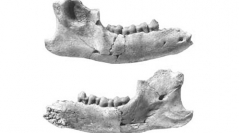

 Geodiversitas
22 (1) - Pages 47-150
Geodiversitas
22 (1) - Pages 47-150The oldest known "condylarth "fauna of the Tertiary of South America comes from basal Palaeocene strata of the Santa Lucía Formation at Tiupampa (Bolivia). It includes five genera and seven species: Molinodus suarezi, Tiuclaenus minutus, T. cotasi n.sp., T.robustus n.sp., Pucanodus gagnieri, Andinodus boliviensis, and Simoclaenus sylvaticus, n.gen., n.sp. Thiswork presents a thorough revision of all the fossils previously described, which are interpreted in the light of recently discovered specimens including materials belonging to three new taxa. The sample contains 33 jaws and 43 isolated teeth. The Tiupampa "condylarths" are included in the Kollpaniinae Marshall, Case & Woodburne, 1990 (=Molinodinae Bonaparte, Van Valen & Kramartz, 1993), a subfamily of the Mioclaenidae (Kollpania tiupampina Marshall & Muizon,1988, the type species of the type genus of the Kollpaniidae Marshall, Case & Woodburne, 1990 is regarded as a junior synonym of Tiuclaenus minutus Muizon & Marshall, 1987). Some of the taxa (e.g., Molinodus suarezi, Tiuclaenus cotasi)are well represented and the cheek dentition of the former is almost completely known. However, other genera such as Andinodus and Simoclaenus are still poorly known (a few lower teeth only in the case of Andinodus). Because of their scant representation, their position within the Kollpaniinae still has to be confirmed by the discovery of new specimens,especially upper molars of Andinodus. The Tiupampa "condylarths" are clearly related to the North American Mioclaenidae, although it is not possible to securely relate them to a specific genus. They share with the North American taxa the following derived characters when compared to Protungulatum: bulbous cusps, the apices of which are approximated in occlusal view; protocone enlarged;stylar shelf greatly reduced or lost; styles reduced and tending to be aligned with para-and metacristae; paraconid appressed against metaconid;entoconid and hypoconulid connate to fused, and forming an obliquely oriented posterolingual crest. The major characteristics of the Kollpaniinae are: metaconid well posterior to protoconid, strongly inflated, and invading the talonid basin posteriorly; loss of the entocristid; hypoconid extremely inflated, occupying at least the medial half of the talonid (generally more); talonid basin reduced to an obliquely oriented groove that is widely opened lingually; posterior slope of the hypoconulid of m3 less convex than in the other mioclaenids. The Kollpaniinae (Tiupampa "condylarths" and Escribania)are also regarded as closely related to the Didolodontidae and Litopterna (especially the Protolipternidae). The key synapomorphy of the three groups is the morphology and development of the paracristid, which is narrower than half the width of the trigonid, deeply arched posteriorly, projected anteriorly, and attaching on the anterior to anterolingual side of the proto-and paraconids. Study of the Tiupampa "condylarths" confirms that the South American Didolodontidae and Litopterna have their origins in North American Mioclaenidae. A parsimony analysis establishes the monophyly of the clade including the North American Mioclaenidae, the Kollpaniinae (South American Mioclaenidae), the Didolodontidae, and the Litopterna. This clade is formally designated as a new order of mammals, the Panameriungulata. Because no close relationships based on dental characters were found with the other groups of South American ungulates (or so-called ungulates)-Astrapotheria, Pyrotheria, Xenungulata, Notoungulata-, it reinforces the unlikelihood of a single origin of the South American ungulates and therefore brings into question the monophyly of the Meridiungulata.
"Condylarths", Didolodontidae, Litopterna, Panameriungulata, early Palaeocene, Bolivia, taxonomy, phylogeny